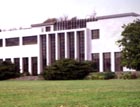Power restored at Charters
Share the chic of this epitome of the style of the 1930s


Art Deco, post-Modernist, Vogue Regency, totalitarian, avant- garde?however you describe it, Charters at Sunninghill, Berkshire, is an arresting building with a uniquely powerful aura. Yet, for the past 45 years or more, few have been aware of its existence.
Designed in 1936 for rich industrialist Frank Parkinson by H.G. Hammond, of Adie Button & Partners, and built ?regardless of expense? by Higgs & Hill, Charters was the last major country house to be built in England before the Second World War. Structurally, the mansion, with its soaring rectangular windows, brick walls clad in gleaming Portland stone and double-height great hall, is unlike most other large 1930s houses, of which few were built in any case.
Technically, it was years ahead of its time, and the arsenal of sophisticated heating, ventilation and labour-saving systems housed in the basement are all still in perfect working order.
Mrs Parkinson, however, was less entranced by the ultra-modern, and insisted on having the interiors designed by her sister in a mix of traditional styles?Queen Anne, early-Georgian, or Louis XVI.
By the time it was completed in 1938, the house cost £155,000, the equivalent of more than £25 million at today?s prices. Six years later, a series of articles in Country Life (November 24 and December 1/8, 1944) recommended the Charters mix of modern and traditional
as a blueprint for future country-house living in a servantless post-war Britain. The vision was short-lived.
Parkinson?s widow continued to entertain the great and the good at Charters following his death shortly after the war, and some poignant Pathé News footage shows the Duke and Duchess of Windsor standing on the steps of the house during their visit in May 1947.
Sign up for the Country Life Newsletter
Exquisite houses, the beauty of Nature, and how to get the most from your life, straight to your inbox.
Two years later, the estate was sold to Sir Montague Burton, ?the tailor of taste?, for £105,000. He died in 1952, and in 1954, Charters was sold at auction for £40,000. Refused planning consent for development, the new owner sold off much of the land until first
Vickers in 1959, and then later De Beers, turned Charters and its 26 remaining
acres into a top-secret research station, effectively wiping the property off the map of Berkshire.
Having bought Charters (now listed Grade II) quietly some three years ago, John Morris, the founder of Sabre Developments, has painstakingly negotiated the complex planning consents required to return the estate to residential use. Now, the first 10 of 39 sumptuous apartments are being offered through Savills (01344 295375), at prices which will range from £1m to £3m, with completion scheduled for 18 months? time.
Work is already under way to create seven grand apartments in the main house, where the newly restored great hall will be a reception area for use by all the owners.
The original wood panelling, marble floors and intricate bronze balustrades have been preserved, and most of the apartments will retain their original Art Deco features, including, in one, the sumptuous marble bathroom designed for Mrs Parkinson. Throughout the building, Parkinson?s incredibly efficient household systems will be upgraded to 21st-century specifications.
The office block built by Vickers in the footprint of the old west wing is being demolished and replaced by a new, 16-apartment building sympathetic in style to the original, but ?no mere pastiche,? Mr Morris insists. He has even tracked down the original architect, now in his nineties, to discuss the concept. Hidden among Charters?s magnificent trees, a second new building will house a further 16 two- and three-bedroom apartments. Nearby will stand the private spa, with its heated 50ft swimming pool, sauna, Turkish bath, gym and snooker room.
Curious passers-by may think of dropping by for a casual look at this monument to early-20th-century wealth and status. But they can think again. The entire security staff of the former research unit has been retained by Sabre Developments. Their job will be to ensure the privacy of the next generation to live at Charters.
Country Life is unlike any other magazine: the only glossy weekly on the newsstand and the only magazine that has been guest-edited by HRH The King not once, but twice. It is a celebration of modern rural life and all its diverse joys and pleasures — that was first published in Queen Victoria's Diamond Jubilee year. Our eclectic mixture of witty and informative content — from the most up-to-date property news and commentary and a coveted glimpse inside some of the UK's best houses and gardens, to gardening, the arts and interior design, written by experts in their field — still cannot be found in print or online, anywhere else.

